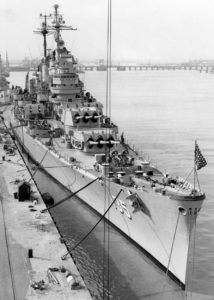Maybe, just maybe, there wouldn’t have been so much fallout over the rat story if we hadn’t had an admiral on board USS Los Angeles. But we did. The admiral didn’t think the “Rats in Long Beach!” story was funny and he made that clear to the ship’s captain.

The captain, who wanted to be an admiral someday, told his second in command that the rat story was not funny at all and he was disappointed, very disappointed, that something like that had happened on his watch. The captain made it crystal clear that he wanted something done about the rat story forthwith.
The executive officer, a commander who wanted to be a captain someday, shoved that poop right on down the hill and by the time it got to our lieutenant it was a full blown poopie storm.
The officer who dreamed up the “Rats In Long Beach!” story and ordered the editor of the ship’s paper to publish it was ordered to apologize, personally, to every man aboard ship, all 1,000 of them. And ask them to sign a paper saying he had apologized. He tried to weasel, approaching several men at a time, trying to make a joke of it, and asking them to sign his rat book.
But word of the lieutenant’s punishment spread quickly and the crew was not about to let him off the hook. Enlisted men would say to him, words to this effect: “I was so worried about my family when I read that story in the paper. I’ve heard you made it up and worried me for nothing. Aren’t you supposed to apologize?”
And the lieutenant would say, “Well, yes.”
And then the enlisted man would order the officer: “So apologize, lieutenant. And then maybe I’ll sign your book.”
This would have been humiliating beyond words for a normal naval officer but the lieutenant was not a normal officer.
[When we were overseas, and underway, officers stood a lot of watches, way more than the average enlisted man. But the lieutenant stood no watches. He wasn’t allowed. I asked him if that embarrassed him, not standing any watches when other officers were bleary eyed from standing so many. He replied, “Did it embarrass Br’er Rabbit when they threw him in the brier patch?”]
When the lieutenant finished apologizing he bound all of the signatures into a book and got a friend to draw a cartoon of rats climbing all over a ship’s compartment. That was page one.
He titled his little book, “Rat Remorse.”
Postscript: I don’t know what happened to the lieutenant but I do know he was transferred and left Los Angeles an hour or so after our ship returned to her home port, Long Beach, California. I was ordered to carry his belongings to the gangway, including a glass ball that was cracked.
“This ball is cracked,” I told him. “What do you want to do with it?”
“I bought it like that,” the lieutenant said. “It was cheaper.”
Coming Monday: The Ku Klux Klan
